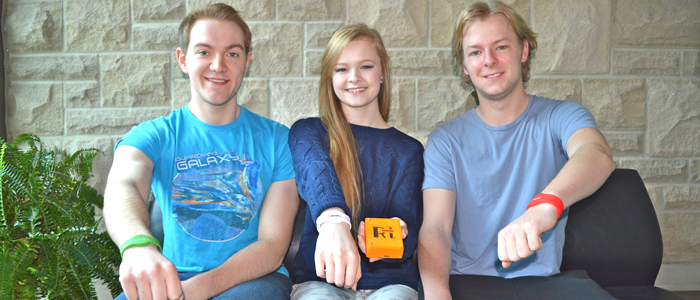Media
Contact
Communications Specialist
Faculty of Engineering
Spencer Engineering Building
Room 2072
Western University
Tel: 519-661-2111 ext. 87015
Email: engineeringcomms@uwo.ca
Preserving contact in times of conflict

Western Engineering News | April 14, 2015
By Jason Teakle
Displaced persons and refugees living in unstable or violent areas across the globe could have a way to find their loved ones amid chaos, thanks to the winning project by first-year engineering students at the 2015 First-Year Design Showcase.
Under the theme of this year’s competition, Providing Humanitarian Aid in Disaster Situations, first-year engineering students Tyler Lacroix, Dana Zagar, Eric Robinson and third-year Chemical Engineering student Kaylin Haill, claimed the top spot in the April 2 competition at Somerville House with their project titled: Restore the Link: Reuniting Families Separated by Conflict – a proposal to leverage the latest electronic technology to allow people separated by civil unrest or war to get back in touch with each other.
As instability grows in vulnerable corners of the world, large international organizations such as the United Nations or International Red Cross would collect data from any residents willing to share as much – or as little – personal information as they are comfortable sharing, in order to populate a centralized database of area residents.
Those who provide their personal information would be given a bracelet – outfitted with a microchip – which would use the identical technology as ‘tap and pay’ for credit cards, for use at console machines stationed in displaced persons or refugee camps.
“Just prior to a crisis, people would link up with friends and family members in a centralized database,” explained Lacroix. “Those wearing the bracelets would tap a console, which would show loved ones who check in where they have been, with at least one console present in each displaced persons camp.”
Security of individuals was of primary importance to the group, said Zagar.
“We chose to have consoles at each displaced persons camp so we are not compromising anyone’s safety,” said Zagar. “Our database provides a general location that is specific enough to reunite relatives in times of crisis, but not as specific as GPS coordinates, which could compromise security.
“In such chaotic times, refugees have everything taken away from them. With Restore the Link, it gives them some sense of control and independence. We wanted to work with organizations like the UN and Red Cross because they have built and established relationships in many of the places where Restore the Link would be helpful.”
The proposal represents a practical and affordable way to make a difference, noted Robinson.
“It would be very helpful to people facing these kinds of conflicts and very possible to implement in such situations,” he said.
The desperation and sense of helplessness many experience in times of political strife would be relieved through direct actions like Restore the Link, explained Lacroix.
“If you are in one of these areas, being able to see if your family members are in refugee camp – or even just moving in a particular direction – would provide at least some level of comfort.”
Nearly 500 students, or a total of 113 groups, participated in the First-Year Design Showcase. Thirty-three judges, including faculty members and representatives from JMP Engineering, Southwestern Ontario Angel Group, Quantum IT, Unifin London and 3M/Trojan/Siemens, assessed the students’ projects.

